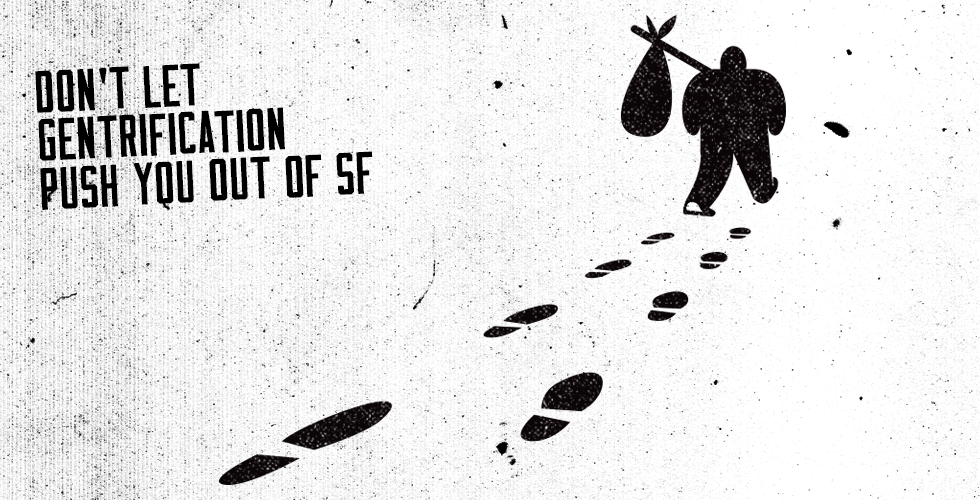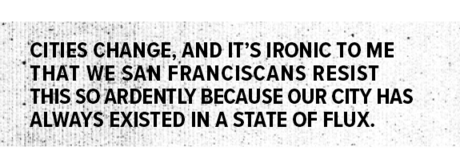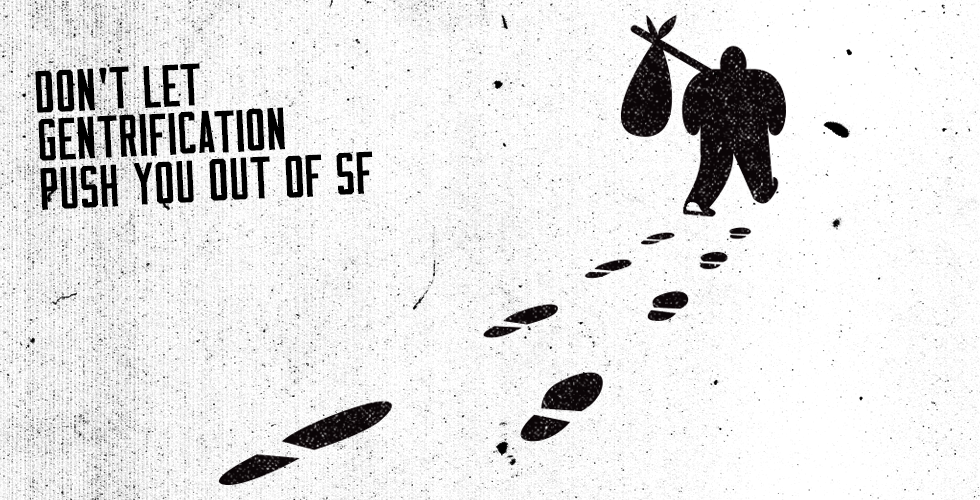
By Anonymous
Like many San Francisco natives, I’m worried about the latest wave of gentrification, but I also have faith that the city will ride it out.
What worries me more is when I hear natives and longtime residents talking about moving somewhere else because they feel the city has somehow changed irreparably. It hasn’t. A community that petitions to rename the Bay Bridge the Emperor Norton Bay Bridge is one remarkably in touch with its history, and I see traces of each San Francisco “phase” wherever I go, whether it’s the Barbary Coast, the Summer of Love, the Castro in its heyday, or countless others. We’re not “losing” our city; rather, we’re piling new things atop the old, as we always have.
Thirty years ago, my parents were the face of gentrification. They’d both been here for about 10 years before deciding that they’d outgrown their Marina flat, and began to search for their first house. Ultimately, they chose Cole Valley over the Duboce Triangle because the Duboce Triangle seemed — believe it or not — too dangerous a place to raise children.
The day they moved in, while they were stalled at an intersection on Haight Street, a green-haired punk spat on the windshield of their car. His attitude didn’t seem to bode well for their new home, nor did the crack den at the corner of Carl and Stanyan Streets, the kitchen that hadn’t been renovated since the turn of the 20th century, or the fact that they’d spent all their savings on the house and couldn’t afford furniture for weeks. But they warmed to the neighborhood quickly — how could they not? They became fast friends with our neighbors, an antique map collector and an Austrian-born painter, whose works still hang in our living room.

They found their private haunts and landmarks: a comedy club down the block from the crack den, which would become Crepes on Cole; a bar that would become a pharmacy; a produce market that would become the pet store where I bought my first hamster, who just happened to be pregnant (my mother bitterly lamented the loss of the produce market after that). The area was gentrifying, and my family was part of that, but Cole Valley was still markedly middle class. It was transitioning into a place where families lived while it still retained a characteristic weirdness that no sub-neighborhood of the Upper Haight can fully shed.
I couldn’t imagine a better place to have grown up. My childhood was full of characters: the guy at Video Nook who hated everyone; the guy at the corner store who oddly sat on a crate instead of a chair, and who hated everyone; the guy with a personal vendetta against people taping signs to telephone poles, and who would stand on the street corner tearing them down. This is not to suggest that everyone was vindictive and bitter, though I did get a kick out of those three. In the backyard I’d dig up old whiskey bottles from when my house operated as an illegal brewery in the 1920s. I grew up in a community, a place with character and history, where we knew our neighbors and where there wasn’t a chain store in sight.
And yet, I took my neighborhood for granted in those days. Walking to school along Haight Street, seeing the washed-up remnants of the Summer of Love, I felt like I’d missed out on something. My parents told me about the Hare Krishnas who frequented our area when I was too young to remember — I missed out on the freaking Hare Krishnas? As I learned more about my city’s history, I became increasingly bummed about the things I hadn’t been around to see.

My parents had to leave San Francisco during my adolescence, and I spent some time as a hapless wanderer. I’ve lived in Ojai, California; Rennes, France; and Montreal, Quebec. And I’ve visited countless more cities, but nowhere I went rivaled what I’d left behind. When I finally made it back for good, I didn’t notice the changes initially. I saw the fog and the hills; I walked along streets that meant something to me; and I felt that I was home again.
But of course, it’s impossible to spend the bulk of one’s life here and not notice changes — some good, some bad. Regardless of whether those changes are a symbol of gentrification, I’m pleased that the corner-store guy and his crate have been displaced by an old-fashioned ice cream parlor. I’m not so pleased about Valencia Street’s upscale transformation of the Mission, but the green-haired punk wasn’t so pleased that my middle-class parents were encroaching on his neighborhood, either. Cities change, and it’s ironic to me that we San Franciscans resist this so ardently because our city has always existed in a state of flux. There’s a phoenix on our city seal, after all.

For so many of us right now, it’s a struggle to find affordable housing, and for those of us who’ve been hit the hardest by gentrification, it’s not always possible to stay. But if you can find a way to make it work, I urge you to stick around. By staying, you pay homage to the San Francisco you remember and can fight to build the San Francisco you want to see: a place with character and diversity where working- and middle-class people can still find houses and apartments to call home. It makes me sad to think I’ll probably never be able to afford a home like the one I grew up in, but the figurative “cost” of leaving is one I’m not willing to pay unless no other option remains.
In order to stomach these waves of gentrification, we have to remind ourselves that some of it is inevitable and that, years later, we might regard it as a great thing. In the 1980s, when the Castro transitioned from a working-class Irish community to a gay mecca, many San Franciscans lost their neighborhood. But out of that loss grew the best-known LGBT village in the world, a civic treasure in its own right. Countless neighborhoods have similar stories. As the San Francisco–based poet Richard Brautigan once said, “Finding is losing something else / I think about, perhaps even mourn / what I lost to find this.”
This doesn’t mean that all change is good or that we should settle for complacency. We can still fight to keep alive the institutions we want to see here and to preserve our community values. But every San Franciscan has a long-lost San Francisco that they miss and a San Francisco that they never got to see. In a recent article for The Bold Italic, Michelle Tea described our city as a Gemini: the sign of the twins, always trying to be two things at once. I think this is the perfect way to characterize San Francisco, a place that’s always changing and a place that can never truly change.
Illustrations by Juan Leguizamon.







